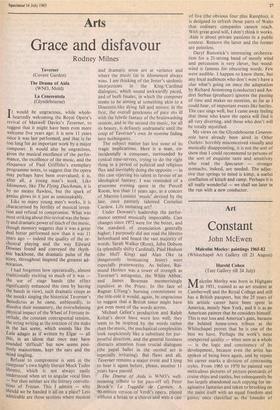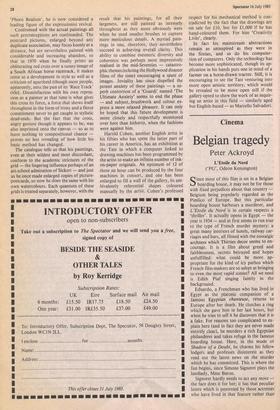Art
Constant
John McEwen
Harold Cohen
(Tate Gallery till 24 July)
Malcolm Morley was born in Highgate in 1931, trained as an art student at Camberwell, and the Royal College and still has a British passport, but the 25 years of his artistic career have been spent in America, mostly New York, and it is as an American painter that he considers himself. This is our loss and America's gain, because the belated home-town tribute at the Whitechapel proves that he is one of the best we have. Perhaps the work's most unexpected quality — when seen as a whole — is the logic and consistency of its development, because even the artist has spoken of being born again, and by repute his career marks a division of contrasting styles. From 1965 to 1970 he painted very meticulous pictures of picture-postcards of cruise ships and castles, but subsequently he has largely abandoned such copying for im- aginative fantasies and taken to brushing on the paint itself with an equal freedom and gusto; once classified as the founder of
'Photo Realism', he is now considered a leading figure of the expressionist revival.
Confronted with the actual paintings all such preconceptions are confounded. The postcard pictures, enlarged beyond any duplicate association, may focus keenly at a distance, but are nevertheless painted with considerable and increasing abandon, so that in 1970 when he finally prints an obliterating red cross over a sunny image of a South African horse racetrack, it makes sense as a development in style as well as a criticism of apartheid (though most people, apparently, miss the pun of its 'Race Track' title). Dissatisfaction with his own repres- sion as a painter at that time is what gives this cross its force, a force that shows itself throughout in the form of irony and a fierce commitment never to get caught in stylistic dead-ends. But the fact that the cross, angry gesture though it appears to be, was also imprinted onto the canvas — so as to leave nothing to compositional chance — proves no less revealing of how little his basic method has changed.
The catalogue tells us that his paintings, even at their wildest and most discordant, conform to the academic strictures of the grid — the lingering influence perhaps of an art-school admiration of Sickert — and just as he once made enlarged copies of picture- postcards, so now he does the same with his own watercolours. Each quantum of these grids is treated separately, however, with the result that his paintings, for all their largeness, are still painted as intensely throughout as they more obviously were when he used smaller brushes to capture more meticulous details. A myriad pain- tings in one, therefore, they nevertheless succeed in achieving overall clarity. This ability to combine mesmeric diversity and coherence was perhaps most impressively realised in the mid-Seventies — catastro- phic themes (echoing the Hollywood disaster films of the time) encouraging a spate of images. Joviality has since dispelled the potent anxiety of these paintings — a su- perb contortion of a `Guarcle named 'The Ultimate Anxiety' seems to end the phase — and subject,,brushwork and colour ex- press a more relaxed pleasure. It can only be hoped that this future development is more closely and respectfully monitored over here than hitherto, when the fashions were against him.
Harold Cohen, another English artist in his fifties who has spent the latter part of his career in America, has an exhibition at the Tate in which a computer linked to drawing machines has been programmed by the artist to make an infinite number of ink- on-paper originals. An optimum of 12 of these an hour can be produced by the four machines in consort, and one has been enlarged to fill a wall of the gallery, its am- bivalently referential shapes coloured manually by the artist. Cohen's professed respect for his mechanical method is con- tradicted by the fact that the drawings are on sale for £10, but for £1,000 if he has hand-coloured them. For him 'Creativity Lives', clearly.
In fact his mainstream abstractions remain as uninspired as they were in the Sixties, and so do his computer- tion of computers. Only the technology has become more sophisticated, though its ap- plication in his hands puts one in mind of a farmer on a horse-drawn tractor. Still, it is encouraging to see the Tate venturing into more open artistic territory, which would be revealed to be more open still if the gallery opted to show the work of as inquir- ing an artist in this field — similarly aged but English-based — as Marcell° Salvadori.







































 Previous page
Previous page